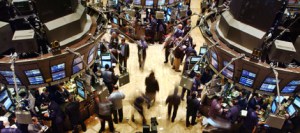


Asia rally on Mexico-U.S. trade announcement fades
Optimism engendered by yesterdays announcement of a preliminary trade agreement between Mexico and the United States initially drove Asian stock markets higher overnight. The Shanghai Composite, for example, climbed 10 points to 2791 in the first half hour of trading....
China stocks bounce big, but there’s reason to think the recovery won’t stick
Stocks in Hong Kong and Shanghai rallied strongly today, Tuesday August 7, after The China Daily, citing an unidentified official at the National Development and Reform Commission, reported that the government would roll out more policies to improve investor appetite...
Day Two of the rally in Shanghai
Granted you can draw a trend line with just two data points, but it doesn’t indicate very strong trend. The Shanghai Composite Index closed up 0.84% last night, taking the index to 3117. This comes after the Wednesday gain of 0.8% to 3091.

Chinese stocks bounce back on better than expected but still tight liquidity
As is so often the case, liquidity was the driver for Chinese stock today, Monday. The Shanghai Composite Index rose 0.78% to 3,154.13 points by the close of trading Monday, after initially falling 0.45% during the morning. Two indexes with more exposure to China’s smaller companies and entrepreneurial sector showed bigger gains. The Shenzhen Component Index rebounded by 2.91%, while the startup-heavy ChiNext exchange gained 3.49%

China slides into correction too: Are Chinese stocks better buy on the dip candidates?
While our eyes have been glued to the volatility in U.S. markets, Chinese stocks have staged their own correction. The Shanghai Composite is down 12.1% from its high on January 24 to the low on Thursday, February 8. With the Lunar New Year and the week-long Spring Festival Holiday almost upon us, it’s not surprising that this is a volatile week.

Notes You Need for December 22: Bitcoin, VR, QCOM, inflation, Nikkei, Shanghai, personal income, BLDP, rig count
In my daily trawling through the market I come upon lots of tidbits of knowledge that I think are important to investors but that don’t justify a full post. I’ve decided to start compiling these notes here each day in a kind of running mini blog that I’m calling Notes You Need. A typical post looks much like this entry from today: 11:20 a.m.: Continued weak inflation in November. The PCE (Personal Consumption Expenditures) index rose 0.2% in November from October. Economists surveyed by Briefing.com had expected a 0.3% month over month increase. The Core PCE was up just 0.1% month over month. “The PCE Index is the Federal Reserve’s preferred inflation measure. Year over year the Core PCE Index is up 1.5%.”

Alibaba plans to use Singles’ Day shopping frenzy to lock in market dominance for years
Alibaba (BABA) generated $1 billion in gross merchandise volume in just the first three minutes of the Singles' Day shopping event in China today. By the end of two hours the sales volume was just shy of $12 billion. The company's Alibaba Cloud unit processed 325,000...
Alibaba’s core business is going great; worries are at the investment margins
Yesterday before the market opened in New York China's e-commerce giant Alibaba (BABA) reported September quarter earnings of $1.29 a share (excluding one-time items.) That was 26 cents a share better than Wall Street projections. Revenue climbed 61% to $8.63 billion...
How do you pick an ETF? Besides liquidity and expenses, indexes count
Let’s say, that after reading my post on asset allocation in my Perfect 5 ETF, you agree and decide that you do want to put 30% of your portfolio into an emerging markets ETF. But which one do you pick?

I’m buying China’s online travel leader CTRIP for my Jubak Picks portfolio today
There are three things to think about before buying Ctrip.com International (CTRP), the leader in China's online travel market. Two of these things are positive and one negative. I think the balance comes down on the positive side but the negative element means the...



